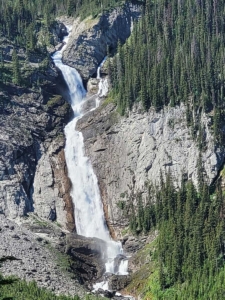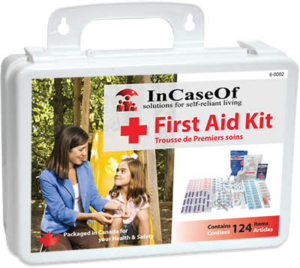First Aid for Hikers: Be Prepared for Outdoor Adventures
Picture this: You’re on a picturesque hiking trail looking deep into the beauty of a canyon, the sun is shining, the water is the most beautiful blue you’ve ever laid eyes on, and the crisp mountain air fills your lungs. It’s a perfect day for an adventure. But wait, you trip and fall down! That’s where first aid for hikers comes into play. I’m here to share some tips to ensure your outdoor escapades stay fun and safe.
#1: First Aid Kit – have one with you!
#2: Bear Spray (if applicable in your hiking zone)
#3: Emergency kit – just in case!
#4: Know before you go: read trail reports, check weather reports, carry maps, tell someone where you’re going and when you expect to return, etc.
The Essentials of Hiking First Aid

Let’s start with the basics. When you hit the trail, you’re stepping into an unpredictable environment, even if you’ve been there before.. Weather can change in an instant, and injuries can happen to even the most experienced hikers. Preventing mishaps is important, so always plan ahead.
- I remember one time when I didn’t check the weather forecast before heading out, and I got caught in a surprise rainstorm. Lesson learned: preparation is key.
Get yourself a reliable hiking first aid kit. Think of it as your trusty sidekick. Customize it to suit your specific needs, but don’t forget essentials like bandages, antiseptic wipes, pain relievers, and blister treatment. (See below for a suggested itemized list)
Common Hiking Injuries and Ailments
Now, let’s talk about the common injuries and ailments you might encounter out there.
- Cuts, scrapes, and abrasions happen to the best of us. Clean it up, cover it, and prevent infection. A small injury can quickly become a big problem if left untreated.
- Sprains and strains can cramp your style. Remember the RICE protocol: Rest, Ice, Compression, Elevation. I carry ankle and knee braces, tensors, and even hiking poles to cover my sprain bases.
- Blisters – oh, the bane of hikers’ existence. Prevention is key here. Properly fitted shoes and moisture-wicking socks can work wonders, plus pre-wrapping or taping areas prone to them. But if you do get a blister, treat it early to avoid misery on the trail. Cover it with a bandage or moleskin. Cut a piece of moleskin into a doughnut shape and place the pad so that it encircles and protects the blister.
- Heat-related illnesses are no joke. Stay hydrated, wear appropriate hats/clothing, and monitor your time in direct sunlight. Recognize the signs of heat-related issues: heavy sweating, nausea, headaches, dizziness, clammy skin, and/or irregular pulse.
- Hypothermia and frostbite are risks in colder climates. Living in Alberta, Canada we do have some experience with winter conditions. Layering is important. Recognizing the symptoms and knowing how to rewarm yourself or a fellow hiker is crucial if you choose to be hiking out in the winter conditions. This is where an All Weather Emergency Heat Retention Bag comes into play. Yes, say that fast 5 times!
First Aid Scenarios:
Let’s dive into some real-world scenarios to see how first aid plays out.
Example 1: Dehydration and Heat Exhaustion
Imagine you’re hiking on a sweltering summer day, and your buddy starts feeling dizzy and weak. It might be dehydration or heat exhaustion.
buddy starts feeling dizzy and weak. It might be dehydration or heat exhaustion.
Action: Give them water, find shade, and cool them down. The key is to act swiftly and avoid the dreaded heatstroke. Continue to communicate, assess your hiking situation and whether you need to seek further assistance. Water sometimes can run low/out and we try to ration it. Consider hiking with a life straw or another form of water filtration system to extend your water abilities in times of need.
Example 2: Ankle Sprain You’re exploring uneven terrain, and you twist your ankle.
Action: Immobilize it and elevate it if possible. Use your one-time use ice pack, tensor bandage or ankle brace. Take some pain killers if needed. Rest and assess whether your group can help you down or if search and rescue or any other help needs to be contacted.
First Aid/Emergency Kit items for Hiking:

- Antiseptic wipes
- Antibacterial ointment
- Band-aids of varying sizes
- Gauze pads
- Medical adhesive tape
- Mole skin or other blister tape/treatment
- Pain medication
- After Bite
- Allergy medication
- Tweezers
- Safety pins
- Cotton Swab/Q-tip
- Disposable gloves and/or mask
- Sanitizer/soap
- Triangular cravat bandage
- Rolled gauze
- Tensor wrap
- Knee/ankle braces
- Prescription medications
- Sunscreen/Bug spray
- Throat lozenges
- Electrolytes (specifically for hot days)
Tools and Supplies
- Knife /multi tool
- Emergency heat-reflecting blanket
- Rain Poncho
- Toilet Paper /other toiletries
- Light stick
- Signal Mirror
- Whistle
- Rope
Remember, it’s not about expecting the worst but being ready for it. The responsibility of hikers is to respect the wilderness and be prepared for whatever it throws our way.
Stay safe out there, and may your hiking adventures be filled with breathtaking views and memorable moments, rather than unexpected mishaps!



